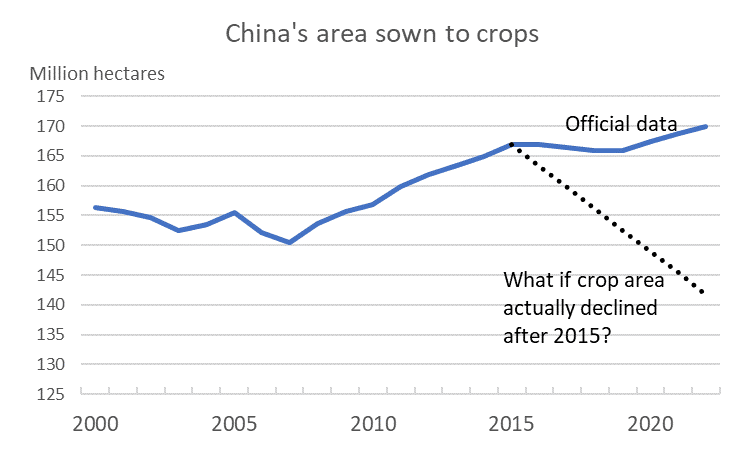Chinese data show a decline in chemical fertilizer that purportedly demonstrates their farmers are reversing their notoriously excessive fertilizer use. But what if the decline in fertilizer use actually reflects a decline in China's agricultural production?
China reported another record grain harvest last week for 2023, Many observers in China were skeptical about the data since the farmland base has been shrinking, there were floods and drought this year, and grain imports are up 7 percent so far in 2023. State media issued a rebuttal to these suspicions, insisting the data are correct.
Chinese statistics show a 17-percent decrease in use of chemical fertilizer use from 2015 to 2022, yet grain output has increased in all but one year during that time--more grain with less fertilizer. Hmm... 2015 was the year Chinese officials launched an action plan to cut annual growth in fertilizer use to zero by 2021. The statistics immediately began showing a decrease in fertilizer use!
How can crop output go up with less fertilizer applied? Chinese officials claim their farmers have produced more grain with less fertilizer because fertilization has become more efficient, but there's no evidence on the ground of this improvement.
 |
| Data from China's National Bureau of Statistics. |
An annual farm cost of production survey conducted by China's National Development and Reform Commission (NDRC) reports no decrease in use of chemical fertilizer use. In fact, fertilizer use intensity has been rising since 2015 for some crops like cotton and wheat. This data is probably not manipulated since it is generally not seen by the public, and you have to look really hard to find the section of the survey with fertilizer use.
 |
| 15 mu = 1 hectare. Data compiled from China National Development and Reform Commission farm production cost surveys. |
Compare the fertilizer use intensity calculated from two data sources. First, the aggregate amount of fertilizer use per hectare of area sown to crops. Second, a weighted average of the NDRC farm survey (each crop's average fertilizer use per hectare weighted by area sown to each crop).
In the chart below it is evident that the official fertilizer data (red line) is surprisingly smooth. Second, it's evident that the two estimates of fertilizer use were fairly close until 2015 when they diverged. The aggregate fertilizer use started dropping, while the estimate from surveys fluctuated around a near constant mean of 400 kg/ha.
These statistics appear contradictory, but what if both statistics are actually accurate? What if per-hectare applications have been stable or increasing, and aggregate fertilizer use is dropping because the area sown to crops has been dropping--i.e. less fertilizer is used because less land is planted in crops? In other words, maybe it's the crop area data that is bogus.
 |
| Data from China National Bureau of Statistics and calculations. |
A thought experiment: Trial and error calculations indicate that it would have taken a 15% decrease in crop area to keep the ratio of fertilizer use per hectare roughly constant from 2015 to 2022--assuming the aggregate fertilizer use statistic is accurate. A decline in crop area of this magnitude seems too large, but China's growth in crop area data does not seem plausible.





No comments:
Post a Comment